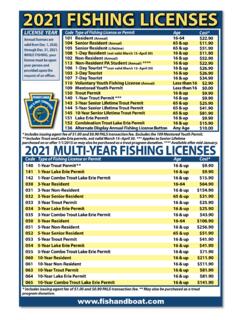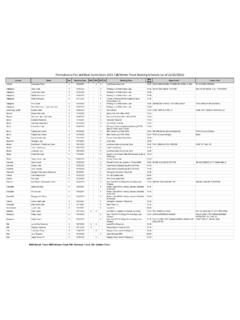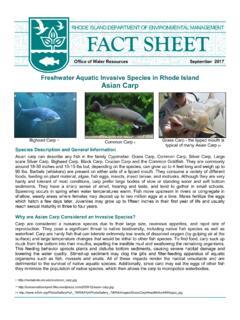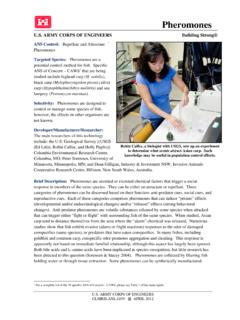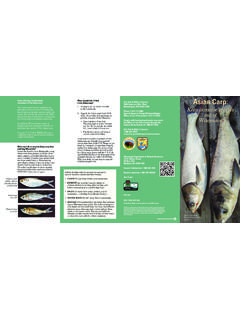Transcription of Aquatic Invasive Species (AIS) Action Plan
1 Aquatic Invasive Species Action plan asian Carp Natural Diversity Section June 2011 Page | 1 Aquatic Invasive Species (AIS) Action plan : asian Carp Complex This Action plan is a living document and will be updated, as needed, to reflect the status of the Species in Pennsylvania. Natural History Description: The term asian carp usually refers to four Species : the bighead, silver, black, and grass carp. Of these, the bighead, silver, and black carp are currently of greatest concern with bighead and silver carp posing the most immediate threats to Pennsylvania. Taxonomy Common name: Bighead carp Family: Cyprinidae Species : Hypophthalmichthys nobilis ITIS Taxonomic Serial Number: 163692 Common name: Silver carp Family: Cyprinidae Species : Hypophthalmichthys molitrix ITIS Taxonomic Serial Number: 163691 Common name: Black carp Family: Cyprinidae Species : Mylopharyngodon piceus ITIS Taxonomic Serial Number: 639618 ITIS-Integrated Taxonomic Information System.
2 Morphology: Bighead and silver carp are both large filter feeding fish that can weigh up to 110 pounds for bighead carp and 60 pounds for silver carp. The body of a bighead carp is laterally compressed with the top being a dark gray color which grades down to off white on its belly. It has many Figure 1. Bighead carp (top), silver carp (center) (both David Riecks, University of Illinois, Illinois-Indiana Sea Grant); black carp (bottom). Aquatic Invasive Species Action plan asian Carp Natural Diversity Section June 2011 Page | 2 dark blotches on its sides. Its head is comparatively large with no scales and a large terminal mouth. The bighead has no teeth and its lower jaw protrudes out farther than its upper jaw. The eyes are situated low on its head and are positioned downward. The silver carp is a deep-bodied fish that is laterally compressed. They are a very silvery in color when young and when they get older they fade from a greenish color on the back to silver on the belly.
3 The silver carp is fairly uniform in color whereas the bighead has irregular dark blotches on its back and sides. The silver carp has a sharply keeled belly from the anal fin to the throat, whereas the bighead carp has a keeled belly from approximately its pelvic fins to the anal fin. The black carp is a blackish-brown fish with blackish-grey fins and an elongated and laterally compressed body that typically grow to more than 3 feet in length and weigh, on average, 33 pounds. All three Species have morphologically unique pharyngeal teeth. Origin: Eurasia, China imported to the southern during the 1970 s and 1980 s. Food Preferences: Bighead and silver carp are voracious, filter feeding, planktivores consuming up to 40% of their body weight daily. Having no true stomach, they feed almost continuously. Black carp feed primarily on molluscs and have molar-like pharyngeal teeth for the purpose. Reproductive behavior: Bighead and silver carp are known to spawn multiple times per year.
4 Their eggs evidently require moving water to keep them suspended during development. Black carp eggs are released only once per year and drift until they settle in calm waters. Bighead and silver carp prefer water temperatures around 25 C for spawning. Black carp spawning occurs at about 26 C to 30 C. Notable Behavioral Characteristics: Silver carp are noted for launching themselves high out of the water when disturbed by boats, skiers, electroshocking, etc. Historic Vectors: asian carp were imported under various private and governmental programs for control of pests in aquaculture facilities in the southern United States. Flooding in the early 1990 s allowed escape of the Species into the Mississippi River system. Current Pathways/Vectors: Black carp have shown only very limited movement since their escape. Bighead and silver carp, have moved unaided steadily and rapidly northward in the major river systems of central North America. There have been sporadic reports of isolated, disconnected occurrences that may be anthropogenic in origin.
5 Release of the Species by humans is a potential secondary pathway. This is particularly true near cities with sizeable asian communities since the fish are sometimes illegally sold in asian food markets. Preferred Habitat: In the upper Mississippi River and lower Illinois River, depending on river flow, both bighead and silver carp Aquatic Invasive Species Action plan asian Carp Natural Diversity Section June 2011 Page | 3 prefer unstructured main channel borders and also show a preference for contiguous backwater open habitats and island side channels. In an Illinois River study, both Species rarely were found in water > 4m in depth. Peak dispersal occurs with rising water levels. At least short term, bigheads can tolerate salinities of 6-12 and temperatures to 38 C with an optimal maximum around 26 C. Little is known of black carp habitat preferences in this hemisphere. Distribution and Status Distribution: Currently, there are no known occurrences of bighead, silver, or black carp in Pennsylvania (Figures 2-4).
6 The closest known occurrence is that of bighead carp in the Ohio River at Moundsville, WV (~ 70 river miles from PA) but sampling at this location only discovered a few isolated specimens. The nearest breeding population in the Ohio is reported to be near Louisville, Kentucky. Black carp have only been found sporadically in the lower Mississippi River system. Bighead and silver carp have spread throughout the major river systems of the central United States. Figure 2. Distribution of bighead carp Hypophthalmichthys nobilis in the United States. Source: USGS. Figure 3. Distribution of silver carp Hypophthalmichthys molitrix in the United States. Source: USGS. Aquatic Invasive Species Action plan asian Carp Natural Diversity Section June 2011 Page | 4 Pennsylvania Legal Status: It is illegal to possess, transport, or introduce bighead carp, silver carp, or black carp in Pennsylvania.
7 All three Species are currently listed in PA Code Title 58 and Threats Bighead and silver carp have the potential to radically alter entire Aquatic ecosystems. Being highly fecund and voracious planktivores that are known to constitute upwards of 90% of the biomass in infested areas, both Species are capable of wiping out the base of the local food web thus depriving native fish and mussel Species of sustenance. Therefore, these Species pose a major economic threat to Pennsylvania s established fisheries. The propensity for silver carp to leap from the water when disturbed has been the cause of several severe injuries to people who have been struck by the fish while skiing, jet skiing, and boating. Black carp, capable of consuming large quantities of molluscs, pose a specific threat to Pennsylvania s rapidly disappearing freshwater mussel fauna. Management Management Goals: Because the asian carp complex has yet to enter Pennsylvania, the ultimate goal is to prevent their invading the state.
8 Given the proximity of bighead carp to the Pennsylvania border and the lack of barriers on the Ohio River to the movement of the fish, it seems likely that the Species will eventually enter our waters. If that occurs, the goals will then become to eradicate the fish or, more likely, manage the Species to mitigate any damage they may cause. Prevention Actions: Little attention and virtually no Federal resources have been devoted to the impending asian carp invasion of Pennsylvania via the Ohio River. Release by humans near larger population centers also needs to be addressed. The following prevention measures are recommended: 1. Communicate and coordinate with government agencies and academia to ascertain the status of asian carp populations in the Ohio River and Great Lakes. 2. Host a meeting involving asian carp experts, government agencies, academia, Figure 4. Distribution of black carp Mylopharyngodon piceus in the United States. Source: USGS. Aquatic Invasive Species Action plan asian Carp Natural Diversity Section June 2011 Page | 5 and others.
9 In order to address concerns with the introduction of asian carp to Pennsylvania s portion of the Ohio River Drainage. 3. Initiate a public education effort to acquaint the populace with the threat of asian carp. Coordinate with PA SeaGrant to institute this initiative. 4. Encourage the incident reporting of Aquatic Invasive Species within Pennsylvania. Online reporting can now be conducted at the following PFBC web site: 5. Strictly enforce 58 Pa. Code and 6. Work with the appropriate PA state agencies to make unlawful any activities that would encourage people to spread asian carp. As example, bow hunting leaping silver carp is fast becoming a popular sport in infested waters. Rapid Response Options: 1. Coordinate the development of an asian Carp Rapid Response plan using the PA state plan as a model. 2. Implement eradication of asian carp populations where applicable. Post Invasion Management: If preventative and rapid response measures fail, the following actions should be considered: 1.
10 Continue public education programs. 2. Encourage the commercial harvest and marketable use of asian carp. 3. Evaluate the need to change regulations under the jurisdiction of the PFBC. 4. Investigate asian carp reproductive and genetic control strategies.* 5. Investigate the feasibility of pheromone trapping. 6. Use the results of current Federal research programs as guidance. * Has some degree of potential for federal assistance. References asian Carp Control Strategy Framework (Draft) 2010. asian Carp Workgroup, February 2010. DeGrandchamp, 2006. Habitat Selection and Movement of Bighead Carp and Silver Carp in the Lower Illinois River. Thesis. Southern Illinois University, Carbondale, IL. 48 pp. Conover, G., R. Simmonds, and M. Whalen, (editors) 2007. Management and control plan for bighead, black, grass, and silver carps in the United States. asian Carp Working Group, Aquatic Nuisance Species Task Force, Washington, 223 pp. Indiana DNR.






